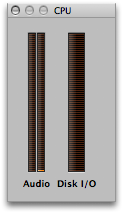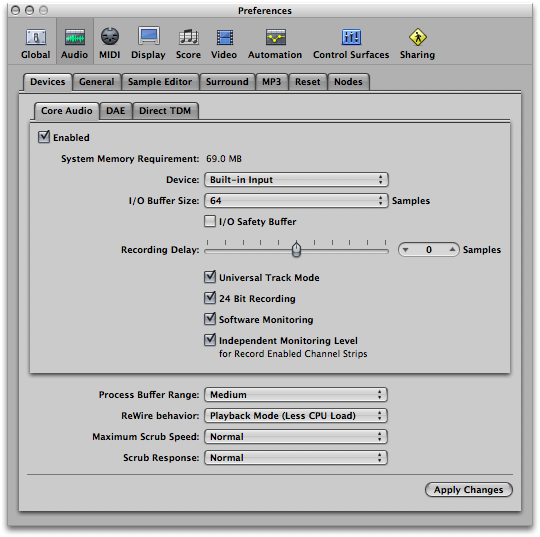When you work with Logic, you may occasionally see this error message:
System Overload. The audio engine was not able to process all required data in time.
The following is a discussion of what this message means, and some strategies to help avoid it.
When you work with audio in Logic, several areas of your computer are put to work. When Logic records and plays back audio tracks CPU power and hard disk I/O capacity is needed. Audio DSP effects and software instruments require CPU power and RAM. No computer has infinite capacity in any of these areas, and there may be times when a Logic project will require more power than your computer is able to deliver at a given moment. When this happens, the System Overload message appears. This dialog is not generally an indication that anything is wrong with Logic or your computer, but is rather an indication that there not enough CPU power, RAM, or hard disk bandwidth to do what the song is asking at the time. You can get an idea of how much of your computer's capacity is in use by looking at the System Performance window. You can access it by choosing Options > Audio > System Performance.


The window has two meters. The Audio meter shows the amount of CPU and RAM capacity used. On multi CPU/core computers, it will be subdivided to show performance for each CPU/core. The Disk I/O meter shows the amount of disk bandwidth used. Watch the meters as the song plays to get an idea of what area may be running short of resources.
System Configuration
The first step in preventing System Overload error messages is to make sure your computer is optimally configured.
- Quit other applications when running Logic. In most cases, open applications that you are not actively using will have little impact on your computer. However, it is possible for other open applications to use enough computer resources to cause overload error messages in Logic.
- Make sure your computer has plenty of RAM. Many DSP effects are heavily RAM dependent. Extensive use of the EXS24 also may require a lot of RAM.
- Be sure that any drive you use to record audio is formatted Mac OS Extended (Journaled). Avoid using UNIX formatting, and don't record to drives formatted FAT32. Use a disk maintenance utility to regularly check and repair your drives' directory structure and to make sure that your files are not fragmented.
- If your projects typically involve many audio tracks, consider a dedicated hard drive for audio. If your computer supports multiple internal drives, then an additional internal 7200 RPM drive would be a good choice. If your computer does not have space for an extra drive, then a FireWire drive may be a good option. Many portable computers have 5400 or even 4200 RPM internal drives, so using a faster FireWire drive may improve audio track performance considerably. Again, look for a 7200 RPM drive.
- If you work with a lot of EXS24 instances in a typical project, then a dedicated drive for sample storage may be worth considering, especially if you use the Virtual Memory option in the EXS24 (see below under Workflow Strategies).
Audio Drivers Preferences
There are several adjustments that can be made in the Audio Drivers window.

- The Input Buffer is like a bucket that must be filled with incoming audio data before it is passed through to the CPU, and the Output Buffer is like a bucket that must be filled with processed audio data before it is passed through to the outputs. The I/O Buffer Size setting controls the size of these buckets. The lower this setting, the less latency between the time you play something into Logic and the time you hear it. The trade-off is that lower buffer settings increase the load on the CPU. Increasing the I/O Buffer Size may prevent System Overload error messages. However, the increased latency may be an issue when recording. One possible strategy would be to work with a low I/O Buffer Size while tracking, and then to increase the size while mixing. The practicality of this approach depends on your workflow. For purely audio recording (not involving Audio Instruments), you may be disable the Software Monitoring check box and monitor your audio directly from the source. In this case, you can set the I/O Buffer Size to a large number even while recording audio.
- The Process Buffer Range: setting determines how large a buffer Logic sets aside for its mixing engine. As with the I/O Buffer Size, smaller settings decrease latency, but increase CPU load. The default setting of Medium is usually fine, but if you experience frequent System Overloads, then try setting it to Large.
- ReWire behavior: comes into play if you are sending MIDI to another application via ReWire. There are two settings Playback Mode (Less CPU Load) and Live Mode (Higher CPU Load). Leave this set to Playback Mode unless you are playing live from Logic into another application through ReWire.
Sample Rate
The song's sample rate directly affects the CPU and hard disk load. For example, if you double the sample rate from 44.1 kHz to 88.2 kHz, you double the amount of data that must be streamed from the hard drive for each audio track to be played. The CPU also must work harder to process the audio. Don't necessarily assume that the highest sample rate your audio interface supports is the best one to use. Always balance the considerations of audio quality, anticipated delivery medium for the final product, and computer performance when selecting the sample rate for any project
Workflow Strategies
As a project progresses, it may reach a "tipping point" where System Overload messages start to appear. Here are some ideas to avoid this:
- Avoid having an Audio Instrument track selected in the Arrange. When an Audio Instrument track is highlighted, Logic must devote enough CPU resources to insure that anything you might play live into the track can be processed. When you are mixing, try to keep an Audio or classic MIDI track highlighted as you work. Only select an Audio Instrument track at times when you are actually working with that particular track.
- Freezing tracks can be a very effective strategy. When a track is frozen, it is rendered as a simple audio file with all DSP, and all plug-ins on the track are disabled in the background. This can save large amounts of CPU power. Keep in mind that freezing Audio Instrument tracks actually adds to the load on the hard disk, so if Disk I/O is the source of overloads, freezing these tracks may be counterproductive.
- Limit the voices used by Audio Instruments. Many of Logic's Audio Instruments offer control over the maximum number of voices available per instance of the instrument. Reducing the number of voices can reduce the CPU load. For example, if you have a Sculpture track that never plays more than two simultaneous notes, then you could reduce the number of voices to two, saving some CPU power for other tasks.
- The EXS24 offers an option to stream samples from disk rather than load them completely into RAM. To access the controls for it, click the Options button in the upper right area of the EXS24 window and choose Virtual Memory.

- The Disk Drive Speed: setting calibrates the performance of Virtual memory to your hard drive. On a modern desktop Mac, either Medium or Fast should be appropriate. On a portable computer with a slow (4200 RPM) disk drive, Slow may be the best option.
- Hard Disk Recording Activity: allows you to balance the performance of the EXS24 streaming with the demands that your audio tracks may place on Disk I/O. If you use very few audio tracks, set it to Less. If you typically work with a large number of audio tracks, Average or Extensive may be the better choice. Whether or not to enable Virtual Memory at all is another trade-off between RAM and hard drive performance. If most of your System Overloads seem to be accompanied by peaks in the Audio meter in System Performance, then enabling Virtual Memory may help, especially if you load lots of EXS24 samples in a typical project. If the Disk I/O meter is peaking, then turning off Virtual Memory may be the better choice. Settings in the Virtual Memory window are global—they affect all instances of the EXS24 in all songs.
- Use Bus channels to share CPU intensive effects among multiple tracks. Whenever possible, avoid putting reverbs and delays on individual channels. Put them on a Bus, and send to them from each track. If a track requires a different sounding reverb than the rest of the song, try a less CPU intensive reverb like the SilverVerb or GoldVerb. If you are processing multiple tracks with the same EQ and/or compressor, insert the plug-ins on a bus and set each track you wish to process to output to that bus.
- Under Logic Pro > Preferences > Audio > General there's a setting for Sample Accurate Automation with three possible settings. The default is Volume, Pan, Sends, but may also be set to Off or Volume, Pan, Sends, Plug-in Parameters. The more automation parameters set to be sample accurate, the more load may potentially be placed on the CPU.
Important: Information about products not manufactured by Apple is provided for information purposes only and does not constitute Apple's recommendation or endorsement. Please contact the vendor for additional information.